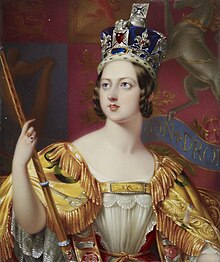|
Rundell and Bridge
Rundell & Bridge were a London firm of jewellers and goldsmiths formed by Philip Rundell (1746–1827)[1] and John Bridge (baptized 1755–1834).[2] History  When Edmond Walter Rundell, nephew of Philip Rundell, was admitted as a partner in 1804, the firm's name changed to Rundell, Bridge & Rundell.[4] That same year John Gawler Bridge, nephew of John Bridge also joined the firm. Following John Bridge's death in 1834 a new partnership was formed comprising John Gawler Bridge, Thomas Bigge, John Bridge's nephews and Bigge's son, and the firm changed its name to Rundell, Bridge & Co.[5] The firm was appointed as one of the goldsmiths and jewellers to the king in 1797 and Principal Royal Goldsmiths & Jewellers in 1804, and the firm held the Royal Warrant until 1843.[6] Amongst its employees were the well-known artists John Flaxman and Thomas Stothard, who both designed and modelled silverware. Directing their workshops from 1802 were the silversmith Benjamin Smith and the designer Digby Scott; and in 1807, Paul Storr, the most celebrated English silversmith of the period, took charge, withdrawing from the firm in 1819 to establish his own workshops.[7] The Royal Goldsmiths served four monarchs: George III, George IV, William IV and Victoria. In addition, their name was attributed to the 'Rundell tiara', made for Princess Alexandra in 1863.[citation needed] Works After the Congress of Vienna (1814–1815), the firm prepared 22 snuff-boxes to a value of 1000 guineas each to be given as diplomatic gifts.[8] In 1830–1831, the firm created the Irish Crown Jewels from 394 precious stones taken from the English Crown Jewels of Queen Charlotte and the Order of the Bath star of her husband George III. The jewels were stolen in 1907 and never recovered.[9] General Mining AssociationRundell, Bridge & Rundell formed the General Mining Association (G.M.A.) in 1827 and opened a colliery in Sydney Mines, Cape Breton, Nova Scotia, Canada the same year and a second colliery in nearby Dominion (then called Lingan and subsequently Bridgeport) in 1830. The G.M.A. operated coal mines and built shipping piers and railways in Cape Breton until it sold its eastern Cape Breton County holdings to the Dominion Coal Company by 1894 and retained its Sydney Mines operations until selling to the Nova Scotia Steel and Coal Corporation in 1900.[10] Bibliography
ReferencesWikimedia Commons has media related to Rundell & Bridge.
|
Portal di Ensiklopedia Dunia